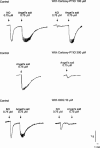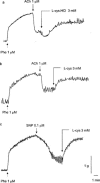Differential actions of L-cysteine on responses to nitric oxide, nitroxyl anions and EDRF in the rat aorta
- PMID: 10694238
- PMCID: PMC1571842
- DOI: 10.1038/sj.bjp.0703058
Differential actions of L-cysteine on responses to nitric oxide, nitroxyl anions and EDRF in the rat aorta
Abstract
1. The effects of L-cysteine were tested in rat aortic rings on responses to nitric oxide free radical (NO(*)), nitroxyl (NO(-)) derived from Angeli's salt and endothelium-derived relaxing factor (EDRF) activated by acetylcholine, ATP and the calcium ionophore A23187. Concentrations of 300 microM or less of L-cysteine had no effect on responses. 2. Relaxations produced by exogenous NO(*) (0.25 - 2.5 microM) were markedly prolonged and relaxations produced by sodium nitroprusside (0.001 - 0.3 microM) were enhanced by 1 and 3 mM L-cysteine. The enhancements by L-cysteine of responses to NO(*) and sodium nitroprusside may be attributed to the formation of S-nitrosocysteine. 3. Relaxations mediated by the nitroxyl anion (0.3 microM) donated from Angeli's salt were more prolonged than those produced by NO(*), and nitroxyl-induced relaxations were reduced by L-cysteine (1 and 3 mM). 4. EDRF-mediated relaxations produced by acetylcholine (0.01 - 10 microM), ATP (3 - 100 microM) and the calcium ionophore A23187 (0.1 microM) were significantly reduced by 3 mM L-cysteine. 5. The similarity between the inhibitory effects of L-cystei on responses to EDRF and on those to nitroxyl suggests that a component of the response to EDRF may be mediated by nitroxyl anion.
Figures






Similar articles
-
Effects of agents that inactivate free radical NO (NO*) on nitroxyl anion-mediated relaxations, and on the detection of NO* released from the nitroxyl anion donor Angeli's salt.Br J Pharmacol. 2001 Oct;134(3):521-8. doi: 10.1038/sj.bjp.0704287. Br J Pharmacol. 2001. PMID: 11588105 Free PMC article.
-
Vascular smooth muscle relaxation mediated by nitric oxide donors: a comparison with acetylcholine, nitric oxide and nitroxyl ion.Br J Pharmacol. 2001 Oct;134(3):463-72. doi: 10.1038/sj.bjp.0704269. Br J Pharmacol. 2001. PMID: 11588100 Free PMC article.
-
Interactions of palmitoyl carnitine with the endothelium in rat aorta.Br J Pharmacol. 1990 Jun;100(2):241-6. doi: 10.1111/j.1476-5381.1990.tb15789.x. Br J Pharmacol. 1990. PMID: 1696151 Free PMC article.
-
What is the relationship between the endothelium derived relaxant factor and nitric oxide?Life Sci. 1989;45(1):1-14. doi: 10.1016/0024-3205(89)90429-3. Life Sci. 1989. PMID: 2664391 Review.
-
Nitroxyl (HNO) as a vasoprotective signaling molecule.Antioxid Redox Signal. 2011 May 1;14(9):1675-86. doi: 10.1089/ars.2010.3327. Epub 2010 Nov 2. Antioxid Redox Signal. 2011. PMID: 20673125 Review.
Cited by
-
In Vitro and in Vivo Imaging of Nitroxyl with Copper Fluorescent Probe in Living Cells and Zebrafish.Molecules. 2018 Oct 6;23(10):2551. doi: 10.3390/molecules23102551. Molecules. 2018. PMID: 30301224 Free PMC article.
-
Analysis of the HNO and NO donating properties of alicyclic amine diazeniumdiolates.Nitric Oxide. 2014 Nov 15;42:70-8. doi: 10.1016/j.niox.2014.08.013. Epub 2014 Sep 2. Nitric Oxide. 2014. PMID: 25192820 Free PMC article.
-
Nitroxyl (HNO): A Reduced Form of Nitric Oxide with Distinct Chemical, Pharmacological, and Therapeutic Properties.Oxid Med Cell Longev. 2016;2016:4867124. doi: 10.1155/2016/4867124. Epub 2015 Dec 7. Oxid Med Cell Longev. 2016. Retraction in: Oxid Med Cell Longev. 2016;2016:4018417. doi: 10.1155/2016/4018417. PMID: 26770654 Free PMC article. Retracted. Review.
-
High oxygen modifies vasodilator effect of cysteine via enhanced oxidative stress and thromboxane production in the rat mesenteric artery.Pflugers Arch. 2016 Sep;468(9):1555-64. doi: 10.1007/s00424-016-1857-y. Epub 2016 Jul 8. Pflugers Arch. 2016. PMID: 27389323
-
Perivascular Adipose Tissue-Enhanced Vasodilation in Metabolic Syndrome Rats by Apelin and N-Acetyl⁻l-Cysteine-Sensitive Factor(s).Int J Mol Sci. 2018 Dec 28;20(1):106. doi: 10.3390/ijms20010106. Int J Mol Sci. 2018. PMID: 30597883 Free PMC article.
References
-
- AKAIKE T., YOSHIDA M., MIYAMOTO Y., SATO K., KOHNO M., SASAMOTO K., MIYAZAKI K., UEDA S., MAEDA H. Antagonistic action of imidazolineoxyl N-oxides against endothelium-derived relaxing factors/nitric oxide through a radical reaction. Biochemistry. 1993;32:827–832. - PubMed
-
- ALERYANI S., MILO E., ROSE Y., KOSTKA P. Superoxide-mediated decomposition of biological S-nitrosothiols. J. Biol. Chem. 1998;273:6041–6045. - PubMed
-
- ARVOLA P., PORSTI I., VUORINEN P., HUHTAJA H., METSA-KETELA T., VAPAATALO H. L-Cysteine augments the vasorelaxation induced by sodium nitrite and SIN-1 but not that due to acetylcholine. Eur. J. Pharmacol. 1992;214:289–292. - PubMed
-
- ASANO M., HIDAKA H. Alterations in pharmacological receptor activities of rabbit arteries by sulfhydryl reagents. Jpn. J. Pharmacol. 1983;33:227–240. - PubMed
-
- BOECKXSTAENS G.E., DE MAN J.G., DE WINTER B.Y., HERMAN A.G., PELCKMANS P.A. The pharmacological similarity between nitric oxide and the nitrergic neurotransmitter in the canine ileocolonic junction. Eur. J. Pharmacol. 1994;264:85–89. - PubMed
Publication types
MeSH terms
Substances
LinkOut - more resources
Full Text Sources
Miscellaneous

